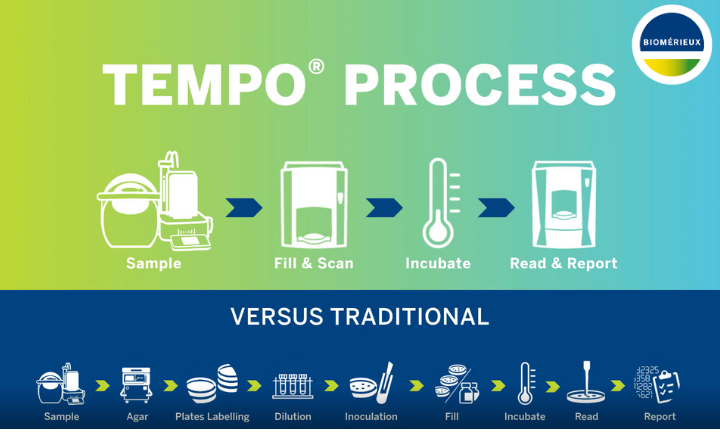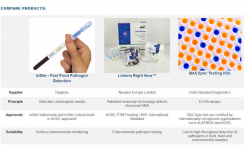Campylobacter is still relatively unknown by consumers. Recent research1 by the German Federal Institute for Risk Assessment on a cohort of 1011 people revealed that less than 30% are aware of the bacteria as a cause of foodborne illness, while 98% are familiar with Salmonella.
Lack of awareness among the general public, however, is in striking contrast with data on foodborne illnesses, where Campylobacter has been the number one cause for several years. In the EU, it accounted for almost 70% of reported zoonoses2 in 2017 (250,000 cases), while in the US it represents 19.5%3 of infections transmitted through food. Reported cases are just the tip of the iceberg, however. The actual number of infections in the EU is believed to be around nine million.4
The fact that millions of people every year contract Campylobacteriosis but very few are aware of it, can be partially explained by the bacteria’s relatively low mortality rate, which was around 0.3% in 2016. In comparison, the rate for salmonellosis and listeriosis in the same year was 0.25% and 16.2% respectively.5 Their mortality in absolute numbers is also higher. Campylobacteriosis can cause severe diarrhoea and dysentery, but is not deadly per se. It can, however, cause fatal complications in vulnerable patients like children, the elderly, or people with immunosuppressing conditions such as AIDS. Campylobacteriosis, for example, is often linked to Guillian-Barré Syndrome6, a rare autoimmune disorder.
Campylobacter colonises in the guts of animals, such as cattle, poultry, sheep, pigs and pets. It can also be found in unpasteurised milk. In most cases, contaminated animals show no symptoms of infection. The bacteria only grows in low-oxygen level environments between 37 and 42ºC, and is unable to multiply outside an animal host or in foods.7
Very common, but hardly reported
Data on food safety incidents in the EU reveals another discrepancy: in 2018, there were only 17 reported food safety incidents related to Campylobacter, while for Salmonella, for example, there were 680 cases.
“This difference,” says EFSA Chief Scientist Marta Hugas, “may partly be explained by the fact that less foodstuffs are a common source of human Campylobacteriosis compared to human salmonellosis. Most frequently, humans get infected with Campylobacter through the consumption of contaminated food, mainly poultry, or water. Whereas, various animals (especially poultry, pigs, cattle, and reptiles) can be reservoirs for Salmonella. Another reason, is that salmonellosis often occurs in outbreaks, while with Campylobacter it’s mostly sporadic cases."
Poultry processing plays an important role
Although campylobacteriosis mainly comes from undercooked broiler and other poultry meat, Campylobacter is not infectious only for chickens. In fact, says Hugas, “Campylobacter is relatively often detected in live pigs and cattle, although it's infrequently detected in their meat. For this reason, they're not considered a common source of human Campylobacteriosis. In a study conducted in 20108 , EFSA concluded that the handling, preparation and consumption of broiler meat may directly account for 20 to 30% of human cases of Campylobacteriosis in the EU.”
There are still gaps in EU regulations
This conclusion on the role of slaughterhouses has led to an amendment to regulation (EC) No 2073/2005 on microbiological criteria for foodstuffs, where there was no provision regarding Campylobacter.
With an effective date on 1st January 2018, the amendment established new sampling criteria on broiler carcasses and an upper contamination limit of 1,000 CFU/g.
Starting from 2020, Member States will be required to monitor the application of this new process and report data to the EU. This is also an important advancement in EU legislation. At the moment, there is no requirement for Member States to report cases of Campylobacter infection. Monitoring is therefore regulated at country level, where, depending on local laws, it can be mandatory, voluntary or simply absent.
“In 2017,” says Hugas, “data on food investigations for Campylobacter reported to EFSA by Member and non-Member States were mainly derived from official, industry and private sampling in the context of national monitoring and surveillance and/or organised surveys. This means that there is currently no food safety criterion for Campylobacter, for food to be put on the market, and no good monitoring data available in the EU to verify the situation of Campylobacter-contaminated foods.”
Antibiotic resistance may not be a determining factor
An important question regarding the dissemination of Campylobacter is the role of antibiotic resistance.
“The situation is complex,” says Hugas. “Some studies of the risk factors associated with the occurrence of Campylobacter have considered the role of antibiotic resistance and antimicrobial use, particularly in broilers, although biosecurity was also identified as a main risk factor for Campylobacter colonization of broilers. The JIACRA II report9 on antimicrobial resistance also identified positive associations between the levels of antimicrobial use and the occurrence of AMR. Nevertheless, if we look at areas with very low antimicrobial use like the Nordic countries, we can see that Campylobacter can still occur. Therefore, as might be expected, antimicrobial usage is probably not essential for Campylobacter dissemination."
References:
1 BfR Consumer Monitor 02 2019
2 The European Union summary report on trends and sources
3 Tack DM, Marder EP, Griffin PM, et al. Preliminary Incidence and Trends of Infections with Pathogens Transmitted Commonly Through Food; Foodborne Diseases Active Surveillance Network, 10 U.S. Sites, 2015–2018.
4 European Food Safety - Campylobacter
5 The European Union summary report on trends and sources of zoonoses, zoonotic agents and food-borne outbreaks in 2016; doi 10.2903/j.efsa.2017.5077
6 Noel McCarthy, Johan Giesecke, Incidence of Guillain-Barré Syndrome following Infection with Campylobacter jejuni; American Journal of Epidemiology, Volume 153, Issue 6, 15 March 2001, Pages 610–614
7 EU publications; Mitigation measures in place for Campylobacter spp. in poultry
8 Scientific Opinion on Quantification of the risk posed by broiler meat to human campylobacteriosis in the EU; EFSA Journal 2010; 8(1):1437
9 ECDC/EFSA/EMA second joint report on the integrated analysis of the consumption of antimicrobial agents and occurrence of antimicrobial resistance in bacteria from humans and food-producing animals doi: 10.2903/j.efsa.2017.4872
























